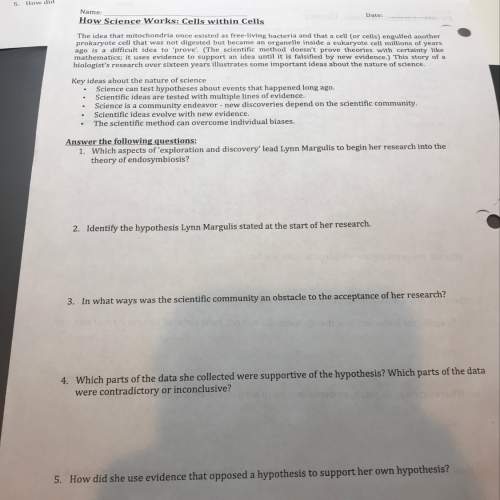
Biology, 13.08.2019 03:20 adiafloresp2dkbx
The human body has about 10 bacterial cells for every eukaryotic cell. bacteria coat our skin, gut, and mouth. also present are protists, archaeans, and viruses. collectively, these organisms are our microbiota. the bacterial species staphylococus aureus is found on the skin and in the nasal passages of about 20% of the human population. in healthy individuals, s. aureus is benign (does not cause harm) in these locations. however, if it is introduced into the bloodstream through, for example, a wound, it can make a person gravely ill. thus, the ecological relationship of s. aureus with a human:
is always mutualistic.
is always antagonistic.
can be mutualistic or antagonistic.
is fixed or unchanging.
is benign.

Answers: 1


Other questions on the subject: Biology

Biology, 21.06.2019 13:00, martintrhernandez
Which is it a characteristic of the animal kingdom? a. they include both vertebrates and invertebrates b. their skin is covered with hair or fur c. they are heterotrophs d. they are eukaryotic
Answers: 2

Biology, 22.06.2019 02:00, naimareiad
The finches on the galapagos island were similar in form except for variations of their beaks. darwin observed that these variations were useful for: attracting a mate defending territory building nests gathering food
Answers: 3

Biology, 22.06.2019 11:30, CurlyheadShay
What is the membrane that sheath of schwann cell containing cytoplasm and nucleus that encloses myelin
Answers: 3

Biology, 22.06.2019 11:30, yarrito20011307
Which of the following statements is true about the relationship between genetic variation and natural selection? a. genetic variation must be present in a population before natural selection can act on it. b. genetic variation arises in a population as a result of natural selection. c. natural selection can act on a population whether there is genetic variation within the population or not. d. after natural selection acts on a population, the amount of genetic variation in the population always increases.
Answers: 1
You know the right answer?
The human body has about 10 bacterial cells for every eukaryotic cell. bacteria coat our skin, gut,...
Questions in other subjects:

History, 29.07.2019 19:30


History, 29.07.2019 19:30

English, 29.07.2019 19:30

History, 29.07.2019 19:30




History, 29.07.2019 19:30

History, 29.07.2019 19:30




